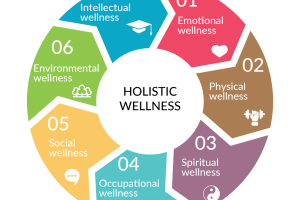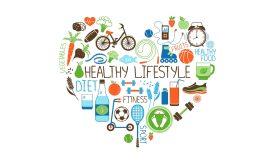A Journey to Wholeness: The Holistic Lifestyle Program You Need

Understanding Holistic Wellness
Holistic wellness represents a shift from the traditional view of health, which often focuses solely on physical symptoms or ailments. Instead, it embraces a comprehensive approach that acknowledges the interconnectedness of mind, body, and spirit. Imagine a body as a well-tuned instrument; when one part is out of harmony, the entire melody suffers. Holistic wellness seeks to strike a balance across all aspects of life, ensuring that emotional, mental, spiritual, and physical health are nurtured collectively. For example, consider someone who struggles with anxiety. If they only focus on treating the physical manifestations—like a racing heart or sweating—they may not resolve the underlying emotional issues. Instead, adopting a holistic perspective encourages them to engage in stress-relieving practices such as yoga, meditation, or talking to a professional, which ultimately leads to healthier coping mechanisms.
- A Journey to Wholeness: The Holistic Lifestyle Program You Need
- Understanding Holistic Wellness
- Benefits of a Holistic Lifestyle
- Mind-Body Connection
- Techniques for Mental Clarity
- Importance of Physical Well-being
- Holistic Diet and Nutrition
- Plant-Based Eating
- Superfoods for Optimal Health
- Emotional Balance
- Practices for Stress Management
- Cultivating Joy and Gratitude
- Spiritual Growth
- Meditation and Mindfulness
- Connecting with Your Inner Self
Benefits of a Holistic Lifestyle
Living a holistic lifestyle has numerous benefits that can manifest in daily life. People often report a greater sense of well-being and fulfillment when they address every facet of their existence. Here are some significant advantages:
- Enhanced Emotional Health: By fostering practices such as gratitude journaling or mindfulness meditation, individuals often experience reduced levels of stress and anxiety.
- Improved Physical Health: A balanced diet and regular exercise not only maintain physical fitness but also boost energy levels and improve mood.
- Greater Mental Clarity: Techniques such as deep breathing or daily reflection allow for focus and productivity, enabling the mind to function optimally.
- Strengthened Relationships: A holistic approach often encourages open communication and better emotional understanding, enhancing personal relationships with friends and family.
- Increased Sense of Purpose: Engaging in activities that nurture one’s spirit, such as community service or creative pursuits, can lead to a more profound sense of belonging and purpose in life.
Adopting a holistic lifestyle may take time, but the rewards are abundant and deeply fulfilling. As individuals embark on this journey, they may find themselves not only improving their well-being but also inspiring those around them to do the same.
Mind-Body Connection
Techniques for Mental Clarity
The mind-body connection is a powerful aspect of holistic wellness, emphasizing how our mental state significantly influences our physical health. Achieving mental clarity is essential for feeling balanced and centered. A few effective techniques can help individuals enhance their focus and sharpen their cognitive skills.
- Mindfulness Meditation: This practice encourages awareness and acceptance of the present moment. By dedicating just a few minutes a day to sit quietly, breathe deeply, and observe thoughts as they come, individuals can cultivate a sense of calmness and clarity. A personal anecdote: When overwhelmed with work stress, dedicating ten minutes each morning to mindfulness meditation transformed my focus and productivity throughout the day.
- Journaling: Writing down thoughts and emotions can help declutter the mind. Whether it’s a gratitude journal or a stream-of-consciousness entry, the act of putting pen to paper can lead to insightful self-discovery, aiding cognitive clarity. Consider making it a daily ritual, perhaps right before bedtime.
- Nature Walks: Simply stepping outside and immersing oneself in nature provides a reset for the mind. The sights, sounds, and smells of nature can stimulate creativity and foster mental clarity, making it an excellent practice for anyone feeling mentally foggy.
Importance of Physical Well-being
While mental practices are crucial, they cannot be separated from the foundation of physical health. Physical well-being plays a central role in enhancing mental clarity and fostering a robust mind-body connection. Here are a few key reasons why prioritizing physical health is essential:
- Exercise Releases Endorphins: Engaging in regular physical activity stimulates the production of endorphins, those feel-good hormones that can significantly boost mood and alleviate stress.
- Balanced Nutrition Fuels the Brain: A nutrient-rich diet that includes whole foods—like vegetables, fruits, and whole grains—directly influences cognitive function. Foods rich in omega-3 fatty acids, like fish or walnuts, help improve memory and focus.
- Adequate Sleep: Never underestimate the power of a good night’s sleep. Quality rest is essential for cognitive function, emotional regulation, and overall health. Aim for 7-9 hours of uninterrupted sleep each night to recharge both mind and body.
Establishing a strong mind-body connection requires an integrated approach that nurtures both mental clarity and physical well-being. Individuals can cultivate a more fulfilling, harmonious life by understanding and addressing their needs across both dimensions.
Holistic Diet and Nutrition
Plant-Based Eating
As we further explore the mind-body connection and its impacts on overall wellness, examining diet and nutrition becomes essential. One approach gaining popularity in the holistic community is plant-based eating. Transitioning to a diet rich in fruits, vegetables, legumes, and whole grains can bring numerous benefits that align with holistic wellness principles. A personal experience illustrates this perfectly. After switching to a predominantly plant-based diet, I noticed heightened energy levels and improved digestion almost immediately. This shift not only supported my physical health but also encouraged mindfulness during meals, making me more attuned to my food choices. Plant-based eating can include:
- Diverse Whole Foods: Incorporate a variety of colorful vegetables, fruits, nuts, seeds, and whole grains to ensure proper nutrient intake.
- Creative Cooking Methods: Experiment with baking, steaming, or stir-frying to make meals delicious and nutritious. For instance, trying a hearty lentil stew or a colorful quinoa salad can be both satisfying and fulfilling.
- Community Resources: Joining local or online communities that focus on plant-based eating can offer support and inspire creativity in cooking.
Superfoods for Optimal Health
Alongside embracing a plant-based diet, incorporating superfoods can significantly enhance overall health. These nutrient-dense foods provide a wealth of benefits, making them a valuable addition to any diet. Some popular superfoods to consider include:
- Chia Seeds: Packed with omega-3 fatty acids, fiber, and antioxidants, chia seeds are versatile and can easily be added to smoothies, yogurt, or oatmeal.
- Quinoa: This protein-rich grain is gluten-free and contains all nine essential amino acids. Use it as a base for salads or as a side dish to boost nutritional value.
- Berries: Blueberries, strawberries, and raspberries are loaded with vitamins, minerals, and antioxidants, making them a delicious way to combat oxidative stress.
- Kale and Spinach: Leafy greens are well-known for their nutrient density, providing essential vitamins and minerals that support overall health.
Integrating superfoods into meals can be as simple as adding a handful to your smoothie or preparing a colorful salad adorned with a variety of these powerhouses. Together, plant-based eating and superfoods can form a solid foundation for anyone looking to nourish their body holistically. By prioritizing these dietary choices, individuals can enhance their physical health, mental clarity, and emotional well-being, leading to a more vibrant and fulfilling life.
Emotional Balance
Practices for Stress Management
As we dive deeper into achieving emotional balance, it’s crucial to address effective practices for stress management. In today’s fast-paced world, stress can often feel overwhelming, impacting not just mental clarity but overall well-being. Implementing simple yet effective stress management techniques can serve as a powerful antidote to everyday pressures. One technique that has significantly helped me is deep breathing exercises. By taking a few minutes to focus on my breath— inhaling deeply through the nose and exhaling slowly through the mouth—I create a moment of pause that calms my mind and body. Here are additional practices to consider:
- Progressive Muscle Relaxation: This involves tensing and then relaxing each muscle group in the body, starting from the toes and progressing to the head. It’s an excellent way to release physical tension.
- Time in Nature: Spending even a short amount of time outdoors can dramatically lower stress levels. A simple walk in the park or sitting quietly in a garden can be rejuvenating.
- Mindfulness Techniques: Incorporating mindfulness into daily routines—like eating, walking, or even during chores—can help maintain a presence in the moment, reducing anxiety about the past or future.
Cultivating Joy and Gratitude
While managing stress is essential, actively cultivating joy and gratitude plays an equally crucial role in maintaining emotional balance. Finding happiness in everyday moments can create a positive feedback loop that fosters resilience against stress. Here are ways to promote joy and gratitude daily:
- Gratitude Journaling: Keeping a journal where you list three things you’re grateful for each day shifts the focus from what’s lacking to the abundance in your life.
- Mindful Moments: Take time to appreciate simple pleasures—a warm cup of tea, the sound of laughter, or a beautiful sunset. Recognizing and savoring these moments can bring immense joy.
- Acts of Kindness: Engaging in small acts of kindness, whether for a stranger or a loved one, can generate feelings of happiness and satisfaction. It could be as simple as complimenting someone or volunteering.
- Celebrate Small Wins: Acknowledge achievements, no matter how minor they seem. Whether completing a task or simply getting through a tough day, celebrating these moments adds to a sense of accomplishment.
By embracing these practices for stress management and actively cultivating joy and gratitude, individuals can achieve greater emotional balance. This positive emotional foundation not only enhances personal well-being but also fosters more meaningful connections with others, ultimately leading to a more harmonious life.
Spiritual Growth
Meditation and Mindfulness
Transitioning from emotional balance to spiritual growth opens up a pathway for deeper self-discovery and fulfillment. At the heart of spiritual growth lie practices like meditation and mindfulness, which not only cultivate a sense of peace but also enhance one’s awareness of the present moment. Meditation, in particular, serves as a powerful tool for deepening spiritual connections. When I first began my meditation journey, I struggled with stillness and silence. However, over time, I discovered that dedicating just ten minutes each day to this practice significantly shifted my perspective. Here are some practical tips to help you get started with meditation:
- Choose Your Space: Find a quiet, comfortable spot where you won’t be interrupted. This creates a sacred environment for your practice.
- Focus on Your Breath: Begin by concentrating on your breathing. Inhale deeply through your nose, hold for a moment, and then exhale slowly through your mouth. This simple act helps center your thoughts.
- Guided Meditations: If you’re unsure where to start, consider using apps or online resources that offer guided meditations. These can provide structure and inspiration.
Similarly, mindfulness embraces awareness in everyday activities, allowing you to fully engage with what you are doing and appreciate each moment. Whether eating, walking, or even washing dishes, practicing mindfulness can reveal joys often overlooked.
Connecting with Your Inner Self
The relationship with your inner self is integral to spiritual growth. Connecting with this deeper part of yourself can foster self-acceptance, clarity, and purpose. Here are a few ways you can cultivate this connection:
- Self-Reflection: Regularly take time to reflect on your thoughts, feelings, and desires. Journaling can be an effective method to articulate these internal dialogues and gain insights into your true self.
- Nature Time: Spend time outdoors, for nature has a unique ability to ground us and help us tune into our internal world. Observing the beauty around you can evoke feelings of connection and purpose.
- Creative Expression: Allow yourself to engage in creative activities like painting, writing, or dancing. These outlets can act as a gateway to express your innermost feelings, providing clarity and insight.
- Gratitude Practices: Reflecting on what you’re grateful for not only strengthens emotional health but also connects you to the essence of your journey and purpose.
By incorporating these practices into your routine, you can foster spiritual growth and a deeper connection with your inner self. This journey is deeply personal and varies from person to person, but each small step taken in self-discovery leads to greater fulfillment and harmony in life.



